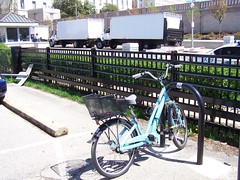A good example of how flawed system design usually leads to failure: the U.S. House bicycle sharing system.

The Hill reports that the U.S. House bicycle sharing system may be scrubbed because it is barely used. See "Capitol bikes gather dust." From the article:
The Chief Administrative Office (CAO) spent $23,000 to lease and maintain 30 bicycles beginning last July. Eight months later, the bikes had been used by less than 3 percent of the House’s staff.
The 175 people signed up for the program have used the bikes a total of 300 times. That means some people have likely used the program only once, and each bike has been ridden about 10 times.
This makes sense because the bicycle stations are in locations far from where workers work, and not close to places where non-drivers come into the area, such as adjacent to the Capitol South Metro Station, or Union Station.
When we first heard about this proposal, see the past blog entry "Institutional memberships in DC bicycle sharing programs" we suggested that instead of creating their own system, the House of Representatives should "pay into" the SmartBikeDC program by outfitting additional stations on the U.S. House campus (and at Union Station), leveraging the value of the extant system and further extending it.
This is a simple concept, based on the concept of innovation diffusion and creating a network or system that supports the new behavior.
The failure of the House bicycle sharing system is comparable to the failure of the Betamax videotape system vs. the VHS system, which succeeded because the 3 hour tape length was superior to the one hour length of the Beta system, and there were fewer impediments to licensing.
Labels: bicycling, bikesharing, change-innovation-transformation, urban design/placemaking



0 Comments:
Post a Comment
<< Home